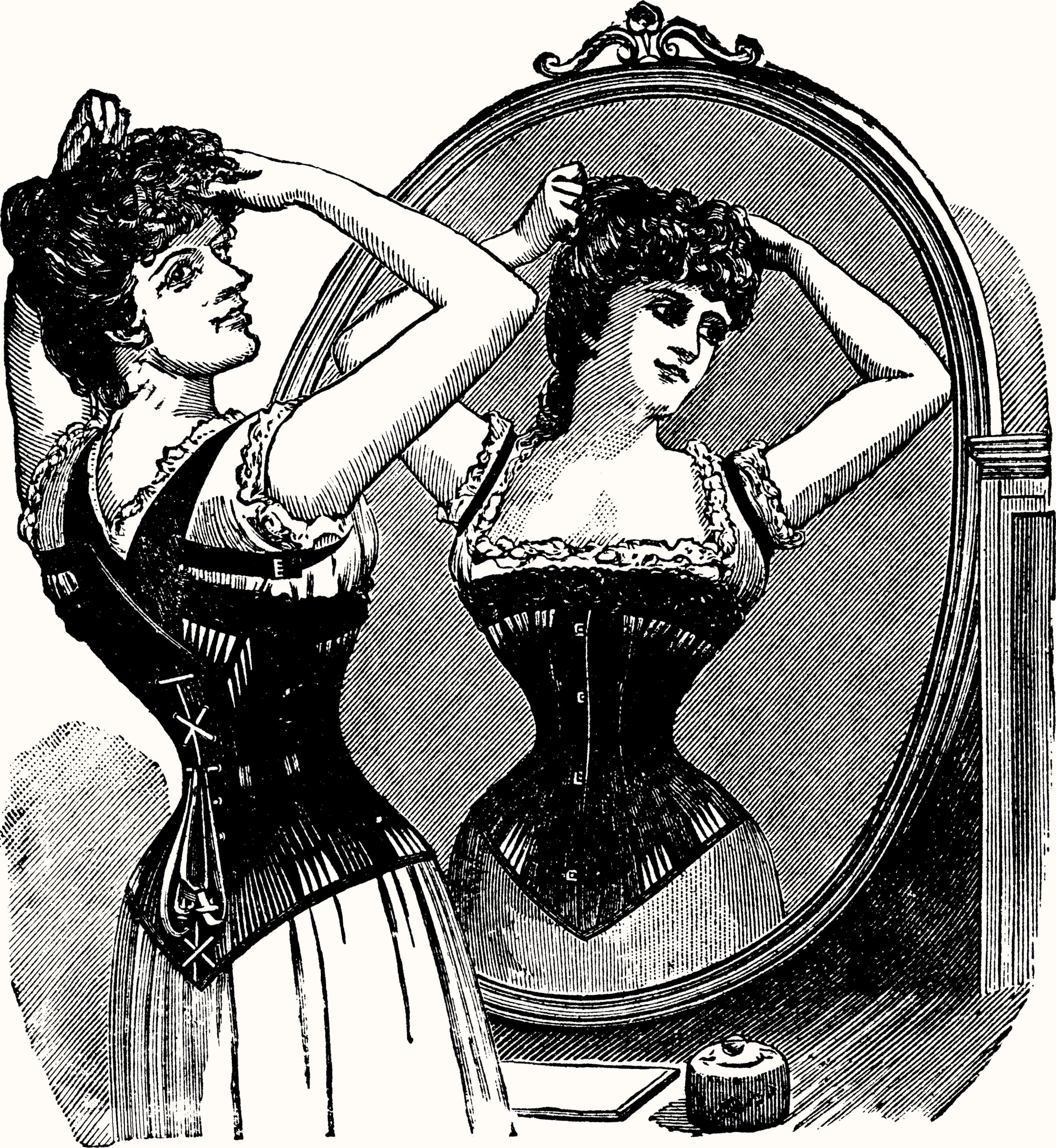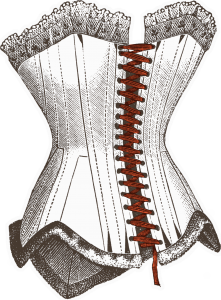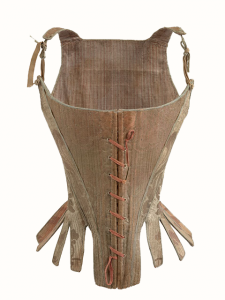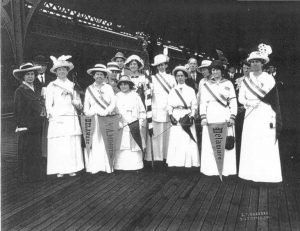This article originally featured in the April 2021 issue of Connect.
by Emily Rich (Yamagata 2017-2020)
“I can’t breathe!” Elizabeth Swann gasps in Pirates of the Carribean, before fainting into the sea. “I was able to squeeze my waist into the size of an orange-and-a-half when I was Prudence’s age,” Lady Featherington says in Netflix’s Bridgerton, while her daughter is tightlaced into a corset. Rose in Titanic and Scarlett O’Hara in Gone With The Wind clutch onto their bedposts while their corset laces are pulled tight.
Everyone has seen a variation of this scene, seen a diagram of shifted organs, or otherwise heard about the horrors of this “medieval torture device”, which, funnily enough, didn’t yet exist during the meideval period. Contemporaries outside of fashion history eagerly correlate corsets as a symbol of women’s oppression. “Thank goodness, we don’t have to wear corsets anymore,” some might say, while others have incorporated corsets into their lifestyles through historic interest, theatre, or Japanese subcultures. But how do these interpretations of corsetry add up to the historical reality?
How were corsets used in the Victorian era?
Every fashion period has a desirable silhouette, and fashion as a whole operates to achieve that silhouette in how garments are constructed and worn. Corsets, and their predecessor, 16th-18th century “stays,” shaped the body to achieve that silhouette, but not necessarily how some might expect.
Corsets and stays were undergarments and were originally worn over a shift or chemise. They were never worn directly against the skin. The shift or chemise protected the more expensive corset or stays from dirt and wear and tear, and protected the wearer from discomfort.
They served many functions, including providing support for the bust and the back. They’re what people were wearing before bras. They also supported multiple layers of clothing—whalebone or steel boning evenly distributed the weight of petticoats, hoop skirts, and heavy skirts or dresses across the torso instead of focusing that weight in the same area of the waistline. Think about layering up your clothes during the winter. Underwear, wool tights, shorts, a slip, a skirt. Maybe even more layers, depending on your preferences. All those layers add up and can create a very uncomfortable and tight waistline. The decades in which corsets and stays were used had even more layers of clothes, throughout all seasons. Corsets and stays eliminate that problem by distributing the pressure evenly throughout the structure provided by boning.
Most importantly, to help achieve a fashion-able silhouette, they kept the front of the torso flat or curved according to the decade’s preference, and shaped the waist closer to an hourglass figure. And yes, some women, in order to have a more dramatic figure, tight-laced their corsets for special occasions. (More on this later!)
Illusion is the name of the game
The job of creating the preferred silhouette did not lie exclusively with the corset or stays, however. Women did not need a physically small waist to be fashionable, they only needed to appear to have one. They could do this in a number of ways, which changed and developed throughout the years. Petticoats or hoop skirts accentuated the hips. “Bum rolls” and bustle skirts made butts look larger. Bust bodices and wide collars made the upper torso appear larger. Padding could be used elsewhere as well, to stuff the bust area or pad out hips and shoulders. Meanwhile, the corset cinched the waist just slightly, and with the padding found elsewhere in clothing, the waist did indeed appear to be quite small.
Additionally, women of all sizes wore corsets for support and to create a more elegant figure, and corsets could be purchased and tailored in all sizes. All waist measurements were not expected to be the same, because each body is different. In fact, maternity corsets also existed for pregnant women, and were designed to make room for growing baby bumps.
The images we have of women posing in corsets or illustrated fashion plates are not everyday women. They’re models, or drawings of unreal women meant to convince the viewer to buy a product, in the same way companies use tiny models and Photoshop today. Even the poses women used to show off their corsets are illusions to a smaller waist. People today know the best angle for selfies, and historical women knew the best angles for their waists. All images of fashion, especially corsets, should be approached with a critical eye, and the question, “Who produced this image, and why?”
“I can’t breathe!”
Tightlacing, sadly, is not a myth. It was not the common practice nor the purpose for corsets and stays. The primary purpose was structural support, and working women wore corsets and stays, just the same as fashionable well-to-do ladies. Corsets were most often laced to the wearer’s comfort level. They were worn loosely, allowing for easy breathing and ease of movement. Women participated in sports, scrubbed floors, danced, and ran. . .all while wearing their corsets and stays.
The idea that tightlacing was expected for corset wearers is easy to disprove when we think about how women were still expected to do everything they would do normally. The click-bait articles we see are largely anomalies that focus on a practice that was popular for only a short time, by a select few women.
With that understanding, some women did choose to tightlace their corsets, especially for special events or occasions. It’s unfortunate that tightlacing is the narrative used so often to define corsetry, but it’s important to remember that every era and society has an ideal body image, and there are always a small group of people who are willing to do whatever it takes to achieve that image. It is not limited only to Victorian women tight lacing their corsets.
Celebrating the corset and the women who designed them
Corsets and women’s fashion were largely designed and manufactured by women. The invention of what we now know as the Victorian corset is often credited to a woman, Madam Roxey Ann Caplin. Madam Caplin was a renowned corset-maker, and a speaker and author about women’s health. Her corsets were awarded medals at the 1851 Great Exhibition. In 1856 she wrote her first book, titled, Corsets and clothing, constructed in accordance with the physiological laws of the human body. Her corset designs were based on support and comfort for the female figure, as well as accentuating natural beauty.
In 1843, Court Magazine commented on her work, saying, “Madame Caplin has made the manufacture of Corsets a complete study, embracing at once the several designs of anatomy, geometry, drawing and mechanics … the artist may be traced in all, and her system of measurement is at once perfect and infallible.”
Madam Caplin is one of many women who were involved in the design and manufacture of corsets and women’s fashion. When we think about the history and purpose of corsets, it’s vitally important to remember that corsets were made by women, for women.
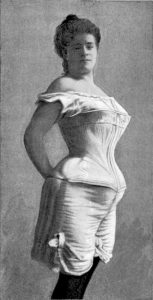 Why do corsets and stays have such a negative image?
Why do corsets and stays have such a negative image?
Fashion was one of the few industries that relied on women. Throughout history, men have been critical of women’s fashion, satirizing it as frivolous or silly. Hoop skirts and bonnets were similarly made fun of and satirized.
Throughout the 1890s and early 20th century, women were becoming more vocal and more active, and the women’s suffrage movement was at its strongest. Men were eager to criticize or discredit women, often based on their appearance, and that extended to how they expressed themselves through fashion. Corsets, a garment women relied on for support, were easy to criticize.
Doctors claimed that corsets were bad for women’s health, and began circulating the myth that corsets shifted organs and ribs, without any substantial evidence to back up those claims. Satirical comics featured grim reapers hovering behind women as they laced their corsets. Newspaper editorials (written almost exclusively by men) attempted to speak out against corset wearing as a frivolous and harmful practice and derided women for subjecting themselves to this torture.
These are the narratives that have survived. Narratives like this are supported by actresses who comment on their costumed corsets which are often ill-fitting or worn incorrectly and by click-bait articles about past and present women who practice extreme tightlacing as a lifestyle statement.
These negative stereotypes have impacted our understanding, but there are wonderful narratives about corsets to remember as well.
Corsets in Japan
During the Meiji period of Japanese history, Western European culture influenced Japan towards industrialization, importing Western style, technology, and fashion. The imperial family in particular acted as a role model, and dressed in Western fashion to showcase Japan’s adoption of Western culture, and to encourage others to do the same.
It caught on for the upper class first, and men and women began wearing Western clothing when they went out in public or for formal events. Sadly, when corsets were imported into Japan, they brought preexisting stigma with them. Predictably, there was concern from foreign doctors when it was initially suggested that women in court officially adopt Western fashion. Dr. Erwin Baelz shared his concerns with the Japanese Prime Minister, Ito Hirobumi, further propagating popular myths about corsets at the time. He later wrote about their meeting, stating, “I urged strongly against it for the reasons that Western clothing is unsuitable […] and wearing a corset would be harmful to the ladies.”
After the corset
When corsets eventually went out of style, the girdle took its place, another support-based shapewear undergarment which was worn up through the 1960s. The girdle, like the corset, supported the figure, acted as fashionable shapewear, and helped women achieve the desired hourglass figure.
As feminism continued to grow in the 20th century, mindsets about undergarments were changing. The classic feminist trope of “bra burning” is perhaps best illustrated by the protest against the Miss America pageant of 1968, when articles of “forced femininity” were thrown into the Freedom Trash Can and burned. These items included girdles, bras, high heels, Playboy magazine, false eyelashes, and yes, corsets. This and other “bra burning” events have further shaped the idea that women are inherently restricted and oppressed by their undergarments.
Women should be admired for standing up for their own gender expression, but it’s worth noting that all people express their gender differently. Some prefer to go braless. Some prefer to wear a corset.
In contemporary settings, we can see corsets in theatre, fashion runways, and Japanese subcultures. Lolita fashion is inspired by Victorian and Rococo styles and motifs. Corsets can be an element of a Lolita coordinate, particularly in Gothic or Aristocrat Lolita, and are often worn on the outside, instead of inside as an undergarment. Steampunk also features corsets, as a fashion and aesthetic that takes its inspiration from the 19th-century Industrial Revolution. In Steampunk fashion, corsets are again typically worn as an outer garment. Other fashions and aesthetics that sometimes incorporate corsetry are historybounding, cottagecore, and visual kei. In the context of these subcultures wearing a corset is seen as self-expression and creates ties to their communities and interests.
Many historical women found that their self-expression was aided by wearing corsets or stays. Women, and everybody else, across every era, has the right to choose how they dress and how they express themselves. Bras, girdles, corsets, and stays are not inherently restrictive or anti-feminist. The expression of femininity is available to anyone, and although corsets or bras are not everyone’s preference, they are a part of women’s history and fashion history. They supported women, were designed by women, and were enjoyed by women.
Interested in trying a corset?
If the history of corset wearing has tickled your fancy and you’re interested in buying a corset while living in Japan, there are a few options from abroad with available international shipping.
The companies I recommend focus on historical reproduction, and their corsets are designed for comfortable everyday wear for historical reenactors, theatrical purposes, and enthusiasts. They are not designed for waist training or tightlacing and focus instead on period accuracy.
The most important thing to remember when wearing a corset is that if it hurts to wear it, it doesn’t fit or something is wrong. A corset should fit your body measurements as closely as possible, following your natural shape!
Red Threaded offers both ready-to-ship corsets and custom/bespoke corsets. (Note: their custom option is on hold due to COVID-19.) Their website includes detailed guides on how to measure yourself to find your size, and how to wear your corset.
Period Corsets also offers ready-to-ship and custom/bespoke corsets. They specify on their website that they offer virtual fittings, which is certainly helpful for customers in Japan!
Historical corsets are expensive and an investment. They are worth their price if you’re interested in the look, but if you are looking for cheaper options that have the style of a corset but not necessarily the structural support, you might want to consider alternative fashion brands that cater to the Steampunk or Lolita subcultures. Both feature corsets in a cheaper price range.
WunderWelt is a trusted online retailer for Lolita fashion, and you can browse several brands at once. They ship domestically in Japan and internationally.
If you choose to express yourself through corsetry, I hope it is as rewarding an experience for you as it has been for me!
Emily was a JET for three years on the coast of Yamagata, in Sakata City. She is now pursuing her library career. In her free time, she enjoys learning about her favorite topics: Robin Hood mythos, fashion history, women’s history, and lesbian history.
Sources:
- Fine Art Museums of San Francisco. (2016, March 29). Corsets in Context: A History. https://www.famsf.org/blog/corsets-context-history
- Honig, M. (2017, November 22). The History of Corsets is More Complicated Than You Probably Think. https://www.bustle.com/p/the-history-of-corsets-is-more-complicated-than-you-probably-think-2779175
- Kaufman, R. (2021, January 08). What ‘Bridgerton’ Gets Wrong About Corsets. https://www.smithsonianmag.com/history/what-bridgerton-gets-wrong-about-corsets-180976691/
- Seo, A. Y. (2012). Adoption, Adaptation, Innovation: The Cultural and Aesthetic Transformation of Fashion in Modern Japan. In J. T. Rimer (Ed.), Since Meiji: Perspectives on the Japanese Visual Arts, 1868-2000 (pp. 473-496). University of Hawai’i Press.
- Levitt, S. (2008, January 03). Caplin,Roxey Ann [formerly Emily Roxey Caplin] (1793–1888), corset Maker, writer, and lecturer on health. https://doi.org/10.1093/ref:odnb/42053
- Żebrowska, K. (Director). (2020, March 28). How Victorian Men Taught Us to Hate Corsets: The Biggest Lie in Fashion History [Video file]. https://www.youtube.com/watch?v=zNwTqanp0Aw&t=565s




